Birobidzhan on the bright side: how we have lit up the city for our money
For several months we were engaged in changing the appearance of the night Birobidzhan. Within the framework of the implementation of the energy service contract, LANIT-PARTNER installed 2200 modern LED lamps of different models, replacing outdated energy-inefficient lamps on the streets of the central city of the Jewish Autonomous Region. Now Sholem Aleichem can “read” at any time of the day.
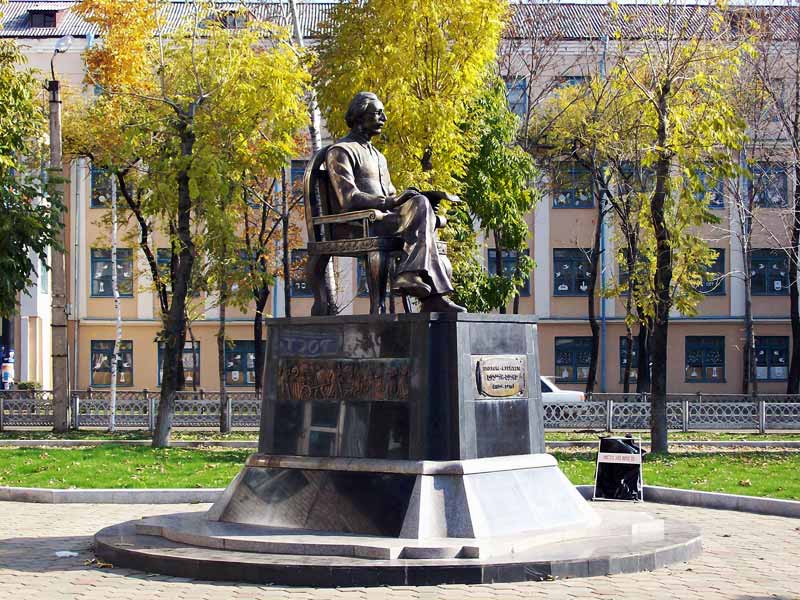
Monument to the writer Sholom Aleikhem (Solomon Naumovich Rabinovich) in Birobidzhan.
A source
Bright times have come not only for the sights of the city: residents received lighted streets, motorists - good visibility on the roads.
Our project has come to an end. We are ready to tell why to invest in modern lighting technologies and how much the urban environment is changing due to changes in the lighting system. In this article, in addition to describing our experience in the implementation of the project, it is discussed why we decided to organize our own production of LED lamps.
')
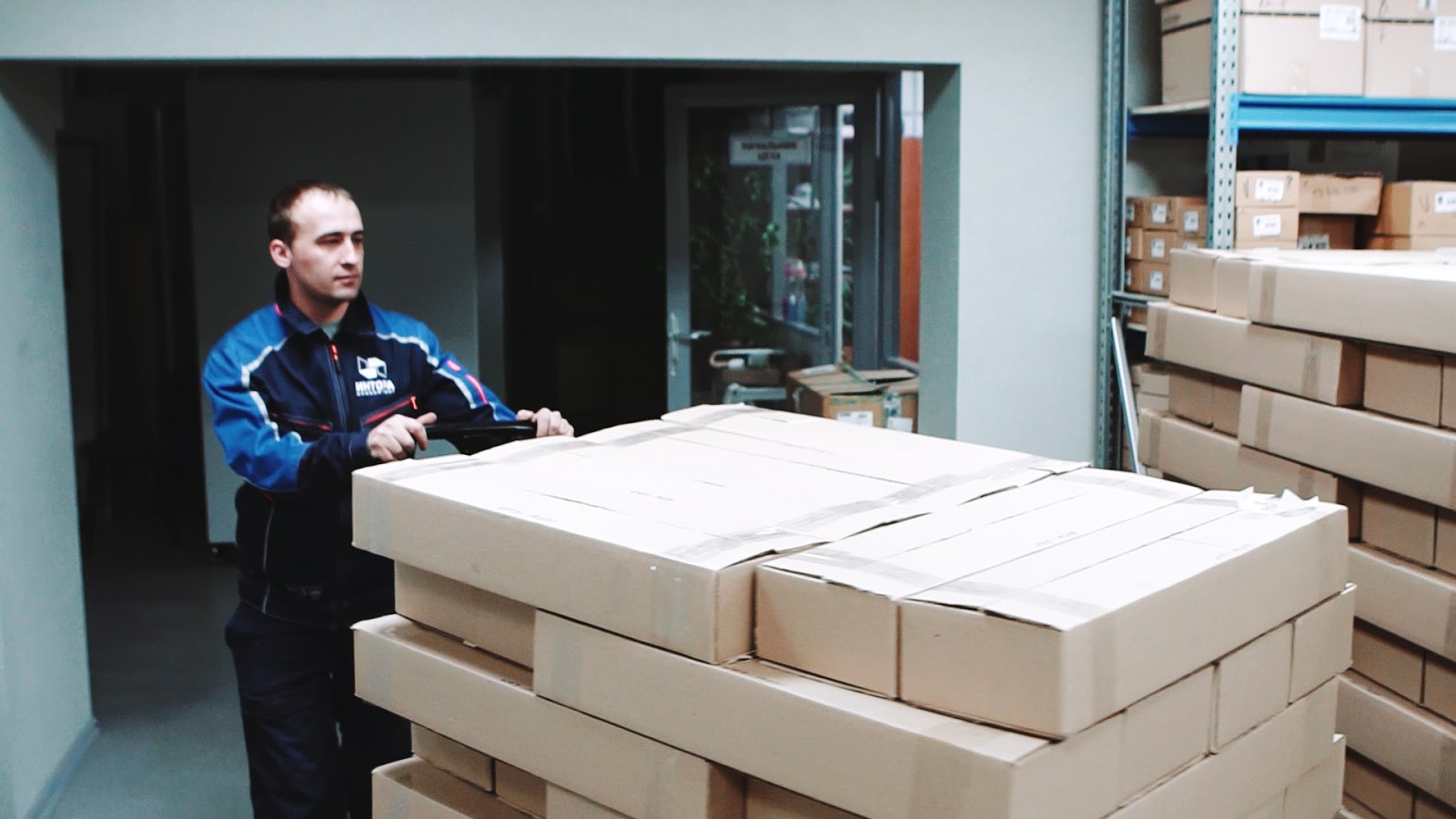
These boxes show the volume of our energy service contract in Birobidzhan. Before plunging into the inimitable toponymic flavor of the city, skillfully highlighted by us with the help of modern diode lamps, I suggest recalling the experience of sunny Spain.
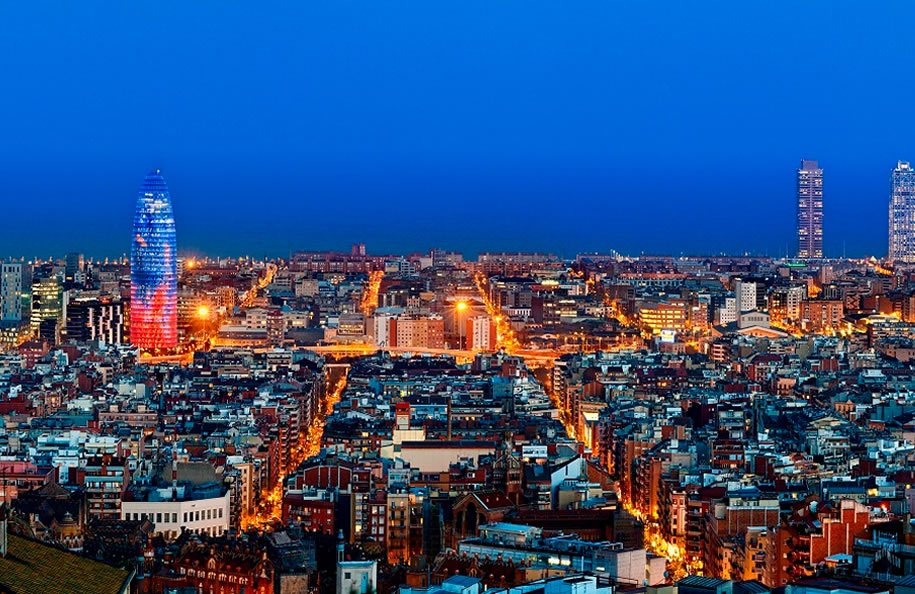
A source
The once successful children's doctor, and in 2011 the candidate for mayor of Barcelona, Xavier Trias, during the election campaign, took the initiative to make the capital of Spanish Catalonia a “smart” city. According to Trias, the active introduction of modern information technologies in the urban environment would contribute to the economic growth of the city. The bet on improving the economic situation through IT has made the Trias election program extremely relevant, since in those years Spain was experiencing a severe recession in the last 25 years.
As a result, on July 2, 2011, the politician ascended to the post of mayor of Barcelona. From this day began the implementation of a comprehensive program to turn an ordinary city into a “smart” one. For this, in addition to the installation of various sensors, smart traffic lights and everything else, it was necessary to solve problems with improving the environmental situation. This implied, among other things, the conversion of the street lighting system - the replacement of inefficient lamps with modern LED lights and the installation of sensors that could be used to regulate the level of illumination of the urban space.
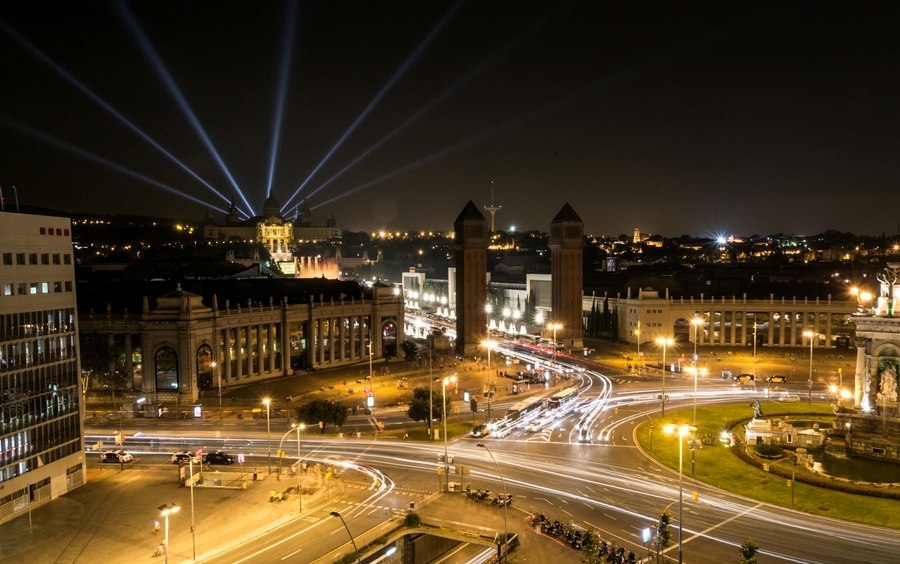
Plaza of Spain in Barcelona
A source
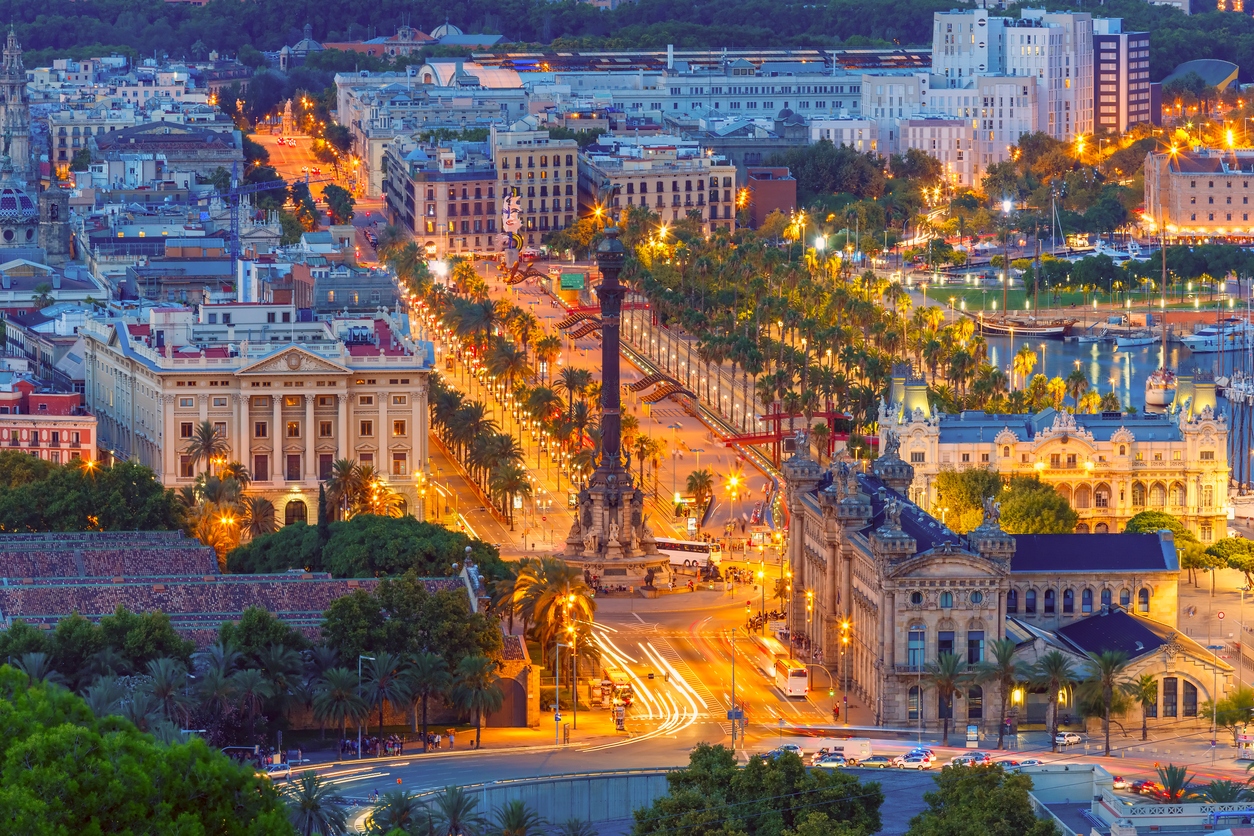
A source
As far as the Mayor of Barcelona managed to realize the planned, you can judge by the rating of Juniper Research : in 2015, the capital of Catalonia was recognized as the “smartest” city on a global scale. And although in subsequent years, other localities became leaders in the “mind”, this does not negate the positive impact of the introduction of modern IT achievements. This is what the city on the banks of the Bira is counting on.
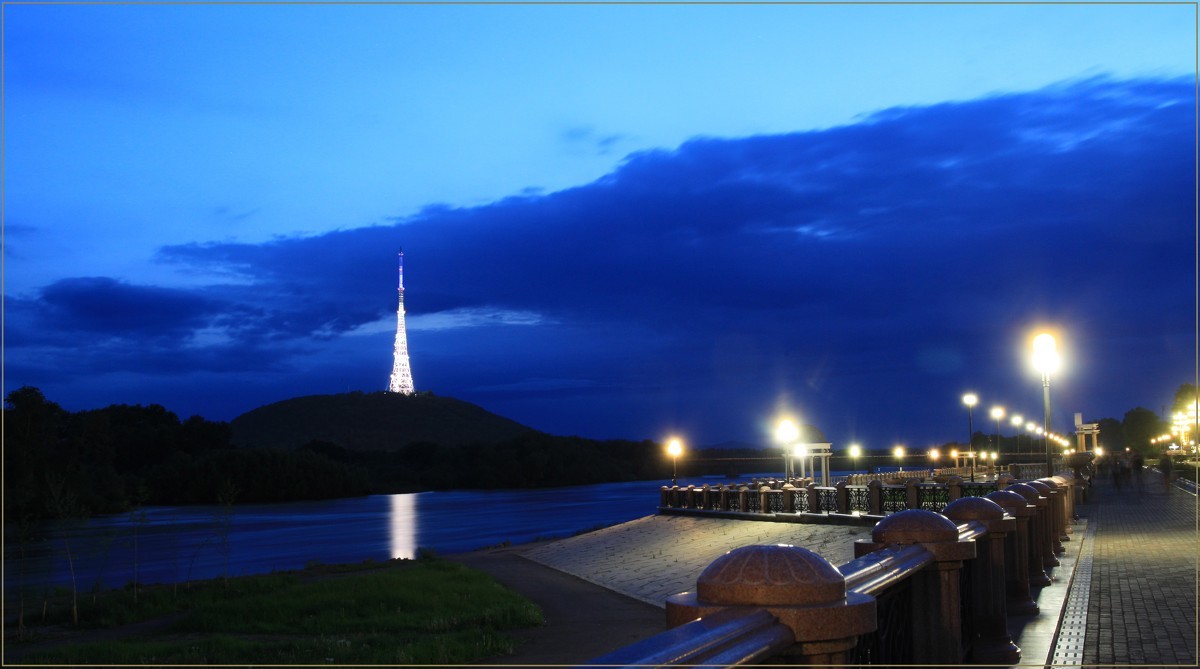
Quay of Birobidzhan
A source
The capital of the Jewish Autonomous Region, although it cannot boast the same climate as in Spain, is in no way inferior to the Catalan capital in terms of improving street lighting. In May, the Khabarovsk company LANIT-PARTNER completed a project here to replace obsolete street lamps with modern LED lamps. Khabarovsk, they say, is jealous.
In the coverage of cities there are many problems. Since 2003, the questions of the irrational use of artificial lighting have become the subject of study by the International Dark-Sky Association and have been called light pollution. According to experts, due to illiterate control of the illumination system, modern cities spend about a third of the electricity in vain. Often the reason for this is the incorrect installation of lighting devices or the use of unsuitable models in different parts of the village.
For Russian cities, it’s not so much the wrong arrangement of the lamps, but the use of outdated and energy-inefficient lamps (with a light output of no more than 12 Lm / W) and lamps with mercury and sodium lamps (up to 55 Lm / W). The situation is often aggravated by the physical deterioration of the lighting equipment as a whole. According to various estimates, the share of "antiques" in lighting systems can reach 60%. This leads to a decrease in the illumination of roads by 2-3 times, which causes a steady increase in accidents.
Failure to comply with building codes ( SNiP 23-05-95 "Natural and artificial lighting") concerning the brightness and uniformity of lighting, not only motorists notice. Visitors to poor light conditions are also visitors to the garden and park areas. The issue is not only in the safety of moving around dimly lit walking areas. For example, high-pressure sodium lamps, often used to illuminate parks, have a rather low color rendering index, which distorts the perception of the surrounding space. Moreover, such lamps can be installed on high poles designed to illuminate highways. This further enhances the visual effects and worsens the overall level of illumination of places of rest.
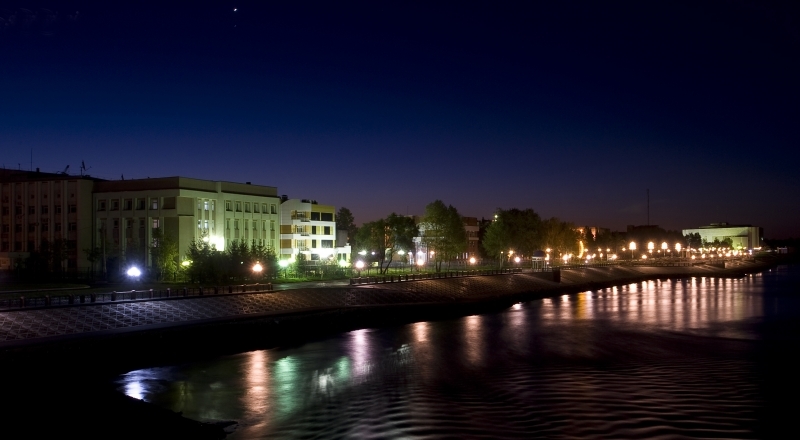
Quay of Birobidzhan
A source
The use of inefficient lighting equipment is fraught with economic consequences. If the power consumption of lamps is high, the city budget incurs significant costs. In this context, it is important to mention that, according to federal law No. 131- “On general principles of local government organization in the Russian Federation”, the coverage of the streets of any settlement — be it a megalopolis or a modest provincial town — is the sole responsibility of local governments. They need to decide where to get funds for the organization or modernization of lighting. Replacing lamps in a city where 100-200 thousand people live, according to various estimates, will cost about 40 million rubles. For larger cities (up to 500 thousand inhabitants) the amount rises to 60-80 million rubles. Next, turn on the arithmetic progression. Naturally, not every city budget can boast of free millions that can be invested in street lighting. There are enough other problems.
At the same time, not everything is as sad as it may seem at first glance. Federal Law No. 261- “On Energy Saving and Increasing Energy Efficiency and On Amending Certain Legislative Acts of the Russian Federation” allows municipalities to attract extra-budgetary funding. This was done in Birobidzhan. As a result, our company took up the project to replace obsolete street lamps.
In total, by the end of May 2017, 2,200 LED lamps of three different models were installed in the city. Where which one to use was determined by the power of each type, the light curve under the design height and a number of other parameters of the projected area.

LED trunk , the luminous flux of which, depending on the model, is from 3800 Lm to 31500 Lm, was installed to illuminate the roads, territories of enterprises and courtyard areas.
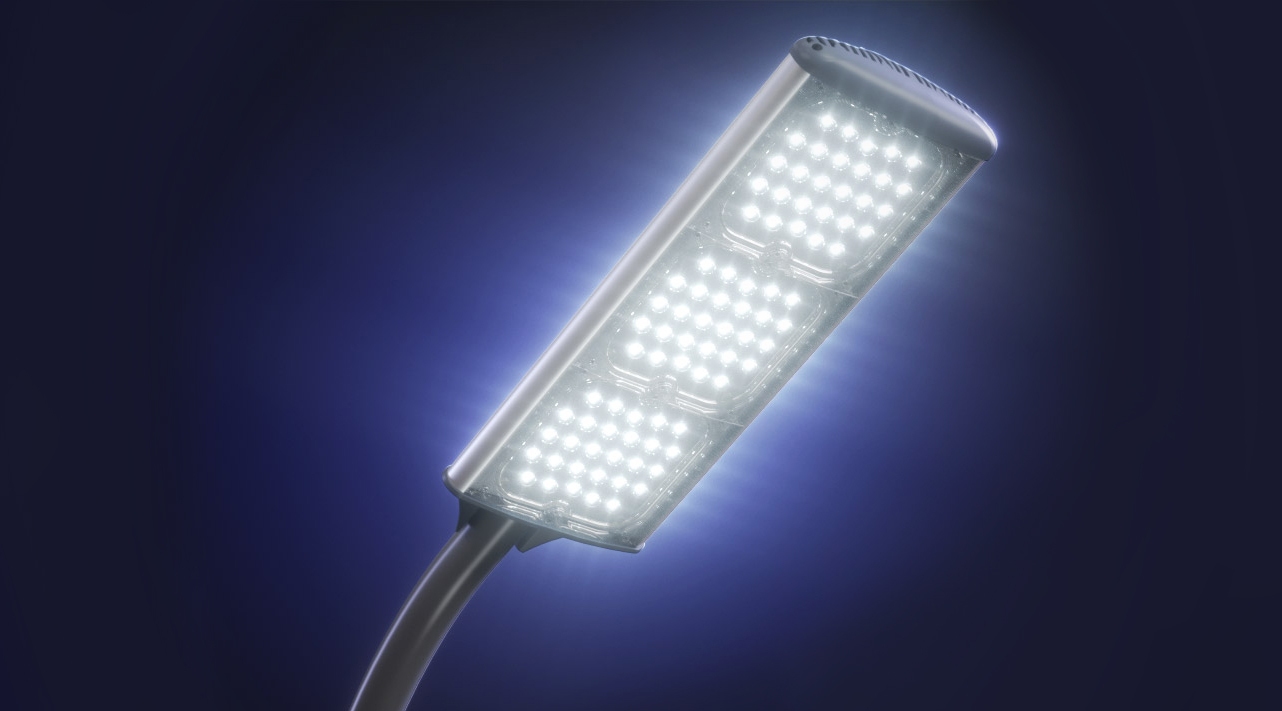
With the help of LED console lamps (the maximum light output is 4500 Lm), parking lots, secondary streets, driveways, etc. were illuminated. Thanks to the possibility of using eight types of lenses, the lamps have a wide range of applications.

Street console LED lamp (lantern) (light output from 3640 Lm to 14,600 Lm) harmoniously fit into the landscape of busy highways, parking lots and parks. Possessing high anti-vandal characteristics, it can also be used for lighting railway platforms and crossings. Designed to replace such fixtures as DRL-125, DNaT-125, DRL-250, DRL-400.
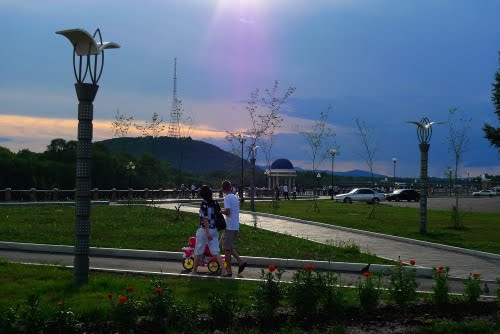 A source
A source
As a result of the replacement of inefficient lighting fixtures and lighting automation, the actual energy consumption of Birobidzhan street lighting systems has almost halved. Old lamps consumed 250-400 watts of electricity, and the new diode - no more than 160 watts. There is reason to expect a cumulative effect in the future - electricity consumption across the city will be reduced by more than 1 million kW / h per year.
LED lamps more profitable and in the sense of durability. Unlike gas-discharge lamps, they do not get very hot, so there is no thermal wear.
Saves the city and maintenance of lamps. To replace the exhausted lamp requires a team of electricians leaving, which is paid from the city budget. Therefore, the less often you have to change the lamp, the better for the treasury. LED lights are designed for 50-60 thousand hours of operation. For comparison, their metal halide relatives will last five to six times less - just 10-11 thousand hours. The conclusions suggest themselves.

A source
Along with the obvious savings, there are other advantages for the city in the use of LED lamps. For example, the issue of bringing the illumination in compliance with regulations is being addressed. The light output of modern LED lamps can reach 135-165 Lm / W (is it worth remembering much more modest indicators of the "light" power of the predecessors ?!). They practically do not have a delay when switching on, while other lamps need to “flare up” to the desired luminous flux.
The only, perhaps, “flaw” of replacing old street lamps with modern ones is that it is often necessary to modernize the power supply network. Outdated systems, uninsulated wires pose a risk to diodes. But this “shortcoming” is easily compensated by an additional bonus from the energy service contract *: all the gas-discharge lamps, instead of which new lamps were installed, remain in the customer’s property. They can be used in unlit areas of the city, which will help reduce crime and accidents. Unfortunately, today for many Russian cities the elimination of dark spots — territories where there is no coverage at all — is among the top priorities.
You don't even have to go for examples. In the “private sector” of Birobidzhan (microdistrict Birobidzhan-2, the villages of Tukalevsky and Partizansky-2) there are unlit streets. Pull back power lines on supports expensive and long. The issue was solved with the help of solar-powered LED lamps. By the way, the same solution was used when equipping the Barcelona seafront with lamps.
Starting to work within the framework of an energy service contract, we are faced with the fact that the market for LED street lamps in Russia is overflowing with offers. Many manufacturers, seeking to win in a competitive race, sacrifice product quality, which is why it is difficult to find good options at a reasonable price. Therefore, we decided to organize our own production, so that the customer can always guarantee the long service of the lamps installed by us.
We began to produce our own lamps on the basis of our company INTORA-Engineering (Khabarovsk), a manufacturer of switchboard equipment in the Far Eastern region. The company produces LuxON UniLED S and LuxON Bat lamps for street lighting and LED spotlights.

The console LED LuxON UniLED S lamp is universal. It is suitable for lighting different areas, since it suggests the possibility of using different lenses.
The advantage of the LED flashlight LuxON Bat, in addition to saving energy, can be considered as a solid-cast aluminum body. It is specially designed for the effective use of LEDs and blends harmoniously into the urban space.
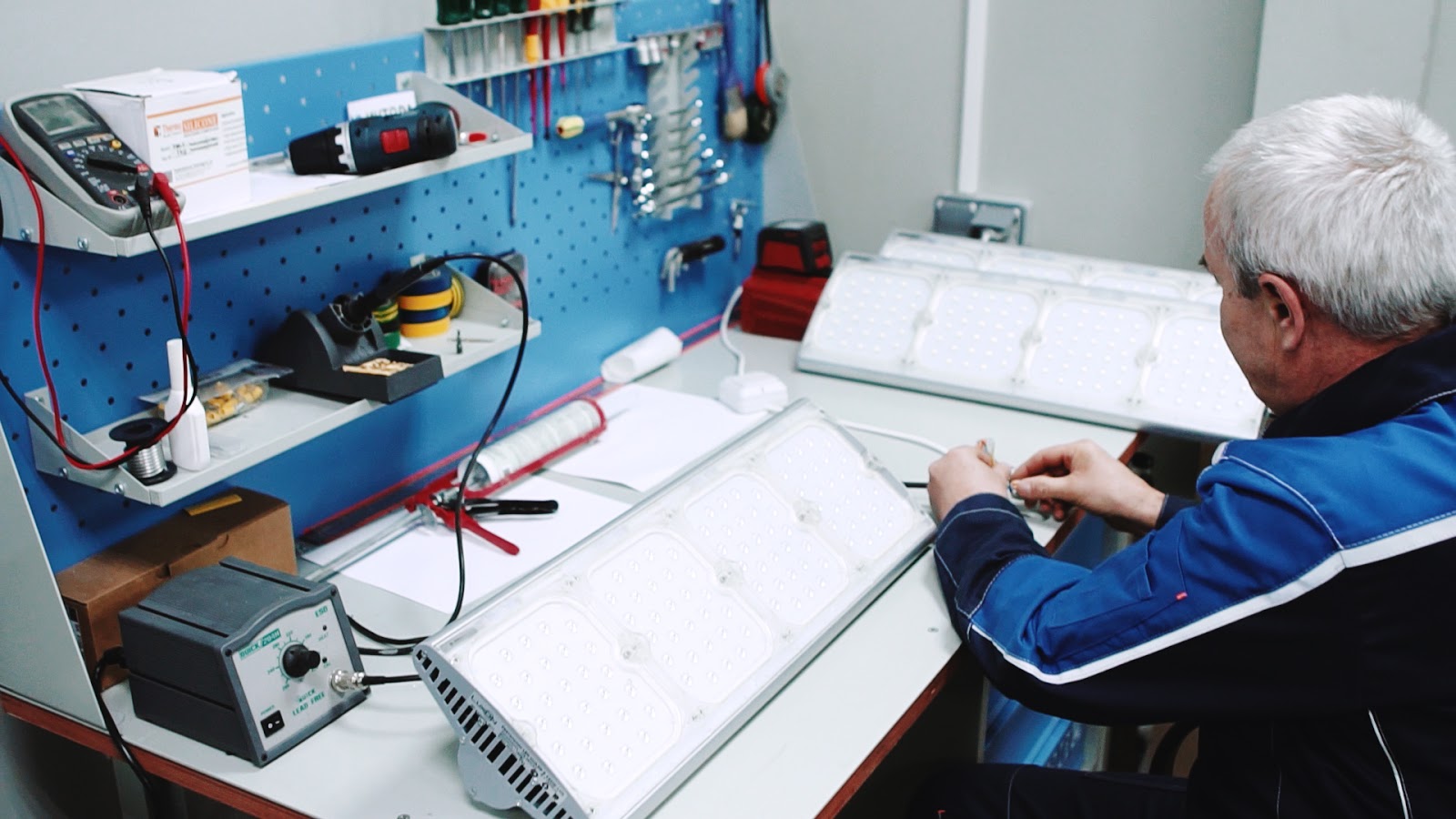
LED spotlights are mainly used to illuminate advertising media and architectural objects. Often they are used in the organization of illumination of warehouses and production shops. INTORA-Engineering produces two types of searchlights - Turtle and LuxON Skat.
The first is a simple and reliable device, ready to come to replace metal halide floodlights. The model range consists of three versions of 18, 24 and 35 watts. The housing design is designed to protect the luminaire from ingress of dust and moisture.
The LED spotlight from the LuxON Skat series can be operated in industrial lighting (production areas), street space (parking, parking, gas stations, advertising platforms) and to illuminate buildings.
The modular system of lighting design allows you to collect light devices of different sizes and capacities, based on the requirements of the project.

Luminaries produced on the basis of the company "INTORA-Engineering", 80% consist of domestic components. By their production the patented technologies are used.

For example, the technology of the packaging of current sources using quartz sand. This increases the maintainability of device drivers.
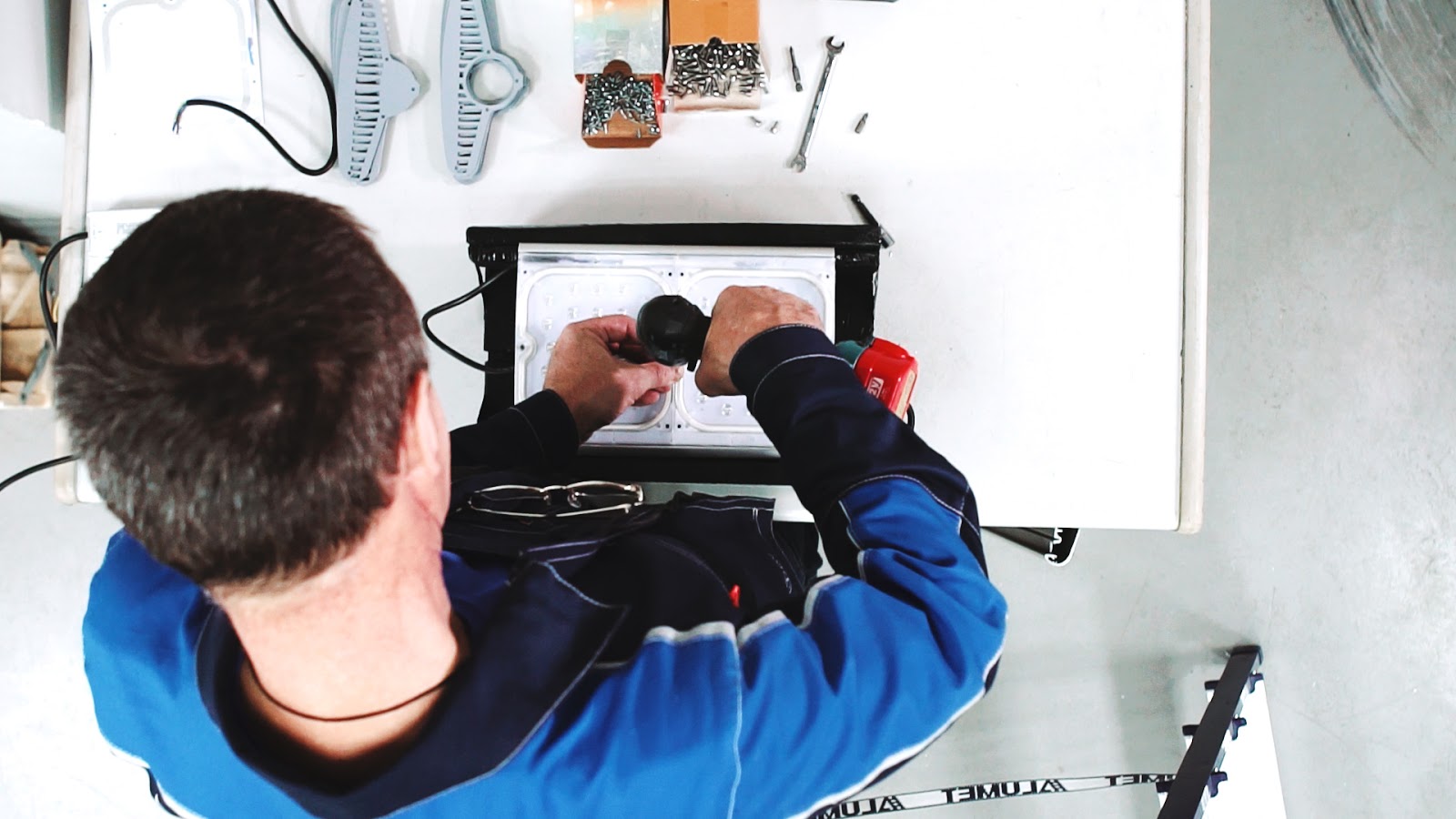
They increase the service life of luminaires (up to 100,000 hours) and the built-in overvoltage protection (380 V) and thermal overheating blocks.

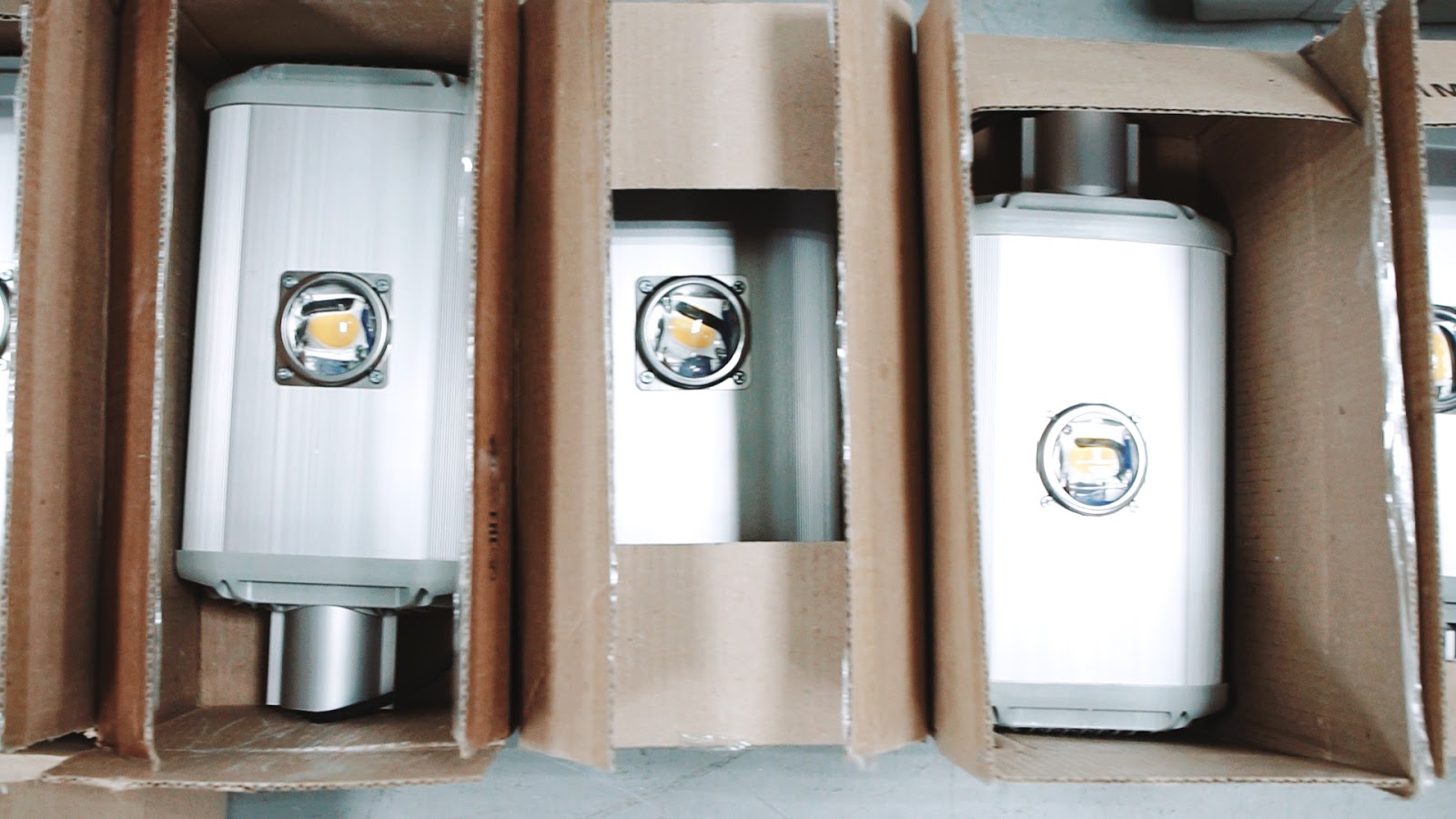

The luminaires are designed according to modern quality standards and meet all stated requirements and standards. By production German OSRAM LEDs with a light stream up to 147 Lm / W and glass from polycarbonate are used. Provides protection from external influences. Efficiency of operation is confirmed by official test reports.
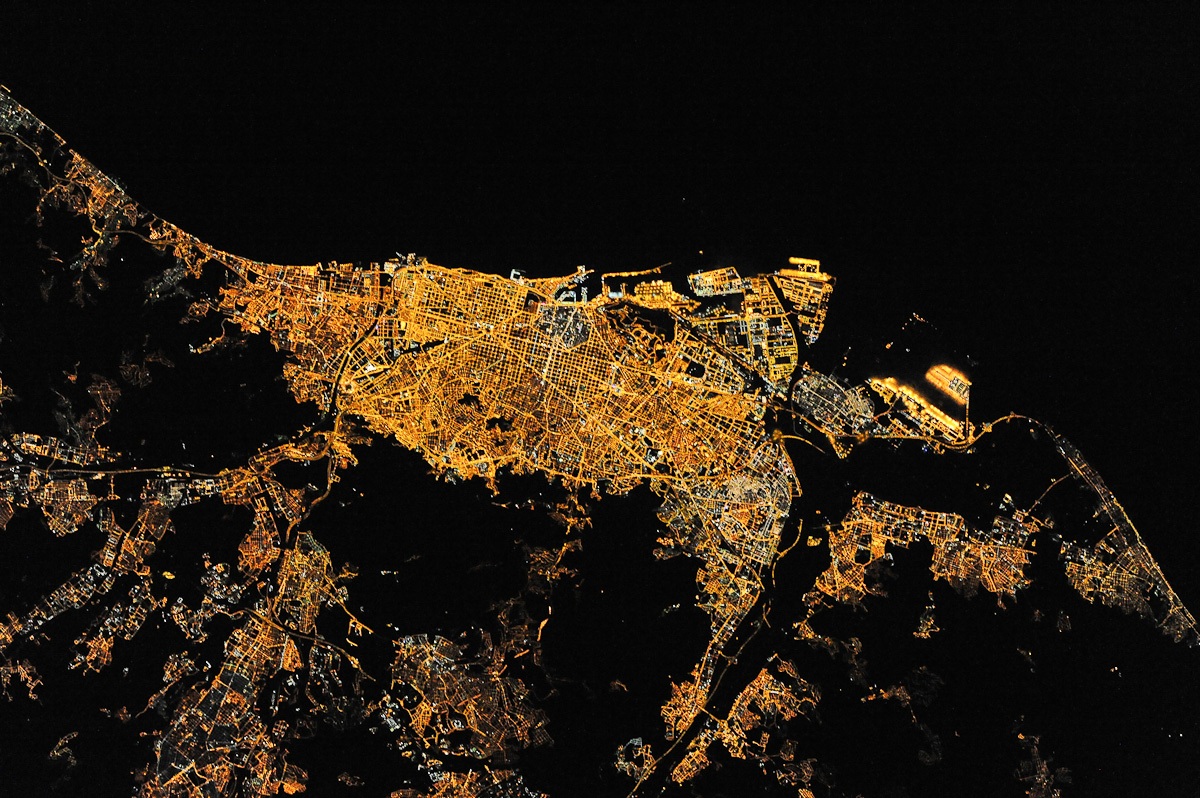
Barcelona We are waiting for pictures of the night Birobidzhan from space
A source
PS While we are developing our own production, Mobile World Capital Barcelona is creating a smart parking: you can reserve and pay for a parking space with one touch of your smartphone screen. Admittedly, companies of the LANIT group are also in trend here. We will tell about our projects in the field of transport in one of the following publications.

Monument to the writer Sholom Aleikhem (Solomon Naumovich Rabinovich) in Birobidzhan.
A source
Bright times have come not only for the sights of the city: residents received lighted streets, motorists - good visibility on the roads.
Our project has come to an end. We are ready to tell why to invest in modern lighting technologies and how much the urban environment is changing due to changes in the lighting system. In this article, in addition to describing our experience in the implementation of the project, it is discussed why we decided to organize our own production of LED lamps.
')

These boxes show the volume of our energy service contract in Birobidzhan. Before plunging into the inimitable toponymic flavor of the city, skillfully highlighted by us with the help of modern diode lamps, I suggest recalling the experience of sunny Spain.

A source
The once successful children's doctor, and in 2011 the candidate for mayor of Barcelona, Xavier Trias, during the election campaign, took the initiative to make the capital of Spanish Catalonia a “smart” city. According to Trias, the active introduction of modern information technologies in the urban environment would contribute to the economic growth of the city. The bet on improving the economic situation through IT has made the Trias election program extremely relevant, since in those years Spain was experiencing a severe recession in the last 25 years.
As a result, on July 2, 2011, the politician ascended to the post of mayor of Barcelona. From this day began the implementation of a comprehensive program to turn an ordinary city into a “smart” one. For this, in addition to the installation of various sensors, smart traffic lights and everything else, it was necessary to solve problems with improving the environmental situation. This implied, among other things, the conversion of the street lighting system - the replacement of inefficient lamps with modern LED lights and the installation of sensors that could be used to regulate the level of illumination of the urban space.

Plaza of Spain in Barcelona
A source

A source
As far as the Mayor of Barcelona managed to realize the planned, you can judge by the rating of Juniper Research : in 2015, the capital of Catalonia was recognized as the “smartest” city on a global scale. And although in subsequent years, other localities became leaders in the “mind”, this does not negate the positive impact of the introduction of modern IT achievements. This is what the city on the banks of the Bira is counting on.

Quay of Birobidzhan
A source
The capital of the Jewish Autonomous Region, although it cannot boast the same climate as in Spain, is in no way inferior to the Catalan capital in terms of improving street lighting. In May, the Khabarovsk company LANIT-PARTNER completed a project here to replace obsolete street lamps with modern LED lamps. Khabarovsk, they say, is jealous.
Causal relationships
In the coverage of cities there are many problems. Since 2003, the questions of the irrational use of artificial lighting have become the subject of study by the International Dark-Sky Association and have been called light pollution. According to experts, due to illiterate control of the illumination system, modern cities spend about a third of the electricity in vain. Often the reason for this is the incorrect installation of lighting devices or the use of unsuitable models in different parts of the village.
For Russian cities, it’s not so much the wrong arrangement of the lamps, but the use of outdated and energy-inefficient lamps (with a light output of no more than 12 Lm / W) and lamps with mercury and sodium lamps (up to 55 Lm / W). The situation is often aggravated by the physical deterioration of the lighting equipment as a whole. According to various estimates, the share of "antiques" in lighting systems can reach 60%. This leads to a decrease in the illumination of roads by 2-3 times, which causes a steady increase in accidents.
Failure to comply with building codes ( SNiP 23-05-95 "Natural and artificial lighting") concerning the brightness and uniformity of lighting, not only motorists notice. Visitors to poor light conditions are also visitors to the garden and park areas. The issue is not only in the safety of moving around dimly lit walking areas. For example, high-pressure sodium lamps, often used to illuminate parks, have a rather low color rendering index, which distorts the perception of the surrounding space. Moreover, such lamps can be installed on high poles designed to illuminate highways. This further enhances the visual effects and worsens the overall level of illumination of places of rest.

Quay of Birobidzhan
A source
The use of inefficient lighting equipment is fraught with economic consequences. If the power consumption of lamps is high, the city budget incurs significant costs. In this context, it is important to mention that, according to federal law No. 131- “On general principles of local government organization in the Russian Federation”, the coverage of the streets of any settlement — be it a megalopolis or a modest provincial town — is the sole responsibility of local governments. They need to decide where to get funds for the organization or modernization of lighting. Replacing lamps in a city where 100-200 thousand people live, according to various estimates, will cost about 40 million rubles. For larger cities (up to 500 thousand inhabitants) the amount rises to 60-80 million rubles. Next, turn on the arithmetic progression. Naturally, not every city budget can boast of free millions that can be invested in street lighting. There are enough other problems.
At the same time, not everything is as sad as it may seem at first glance. Federal Law No. 261- “On Energy Saving and Increasing Energy Efficiency and On Amending Certain Legislative Acts of the Russian Federation” allows municipalities to attract extra-budgetary funding. This was done in Birobidzhan. As a result, our company took up the project to replace obsolete street lamps.
When the East is smart
In total, by the end of May 2017, 2,200 LED lamps of three different models were installed in the city. Where which one to use was determined by the power of each type, the light curve under the design height and a number of other parameters of the projected area.

LED trunk , the luminous flux of which, depending on the model, is from 3800 Lm to 31500 Lm, was installed to illuminate the roads, territories of enterprises and courtyard areas.

With the help of LED console lamps (the maximum light output is 4500 Lm), parking lots, secondary streets, driveways, etc. were illuminated. Thanks to the possibility of using eight types of lenses, the lamps have a wide range of applications.

Street console LED lamp (lantern) (light output from 3640 Lm to 14,600 Lm) harmoniously fit into the landscape of busy highways, parking lots and parks. Possessing high anti-vandal characteristics, it can also be used for lighting railway platforms and crossings. Designed to replace such fixtures as DRL-125, DNaT-125, DRL-250, DRL-400.

As a result of the replacement of inefficient lighting fixtures and lighting automation, the actual energy consumption of Birobidzhan street lighting systems has almost halved. Old lamps consumed 250-400 watts of electricity, and the new diode - no more than 160 watts. There is reason to expect a cumulative effect in the future - electricity consumption across the city will be reduced by more than 1 million kW / h per year.
LED lamps more profitable and in the sense of durability. Unlike gas-discharge lamps, they do not get very hot, so there is no thermal wear.
Saves the city and maintenance of lamps. To replace the exhausted lamp requires a team of electricians leaving, which is paid from the city budget. Therefore, the less often you have to change the lamp, the better for the treasury. LED lights are designed for 50-60 thousand hours of operation. For comparison, their metal halide relatives will last five to six times less - just 10-11 thousand hours. The conclusions suggest themselves.

A source
Along with the obvious savings, there are other advantages for the city in the use of LED lamps. For example, the issue of bringing the illumination in compliance with regulations is being addressed. The light output of modern LED lamps can reach 135-165 Lm / W (is it worth remembering much more modest indicators of the "light" power of the predecessors ?!). They practically do not have a delay when switching on, while other lamps need to “flare up” to the desired luminous flux.
The only, perhaps, “flaw” of replacing old street lamps with modern ones is that it is often necessary to modernize the power supply network. Outdated systems, uninsulated wires pose a risk to diodes. But this “shortcoming” is easily compensated by an additional bonus from the energy service contract *: all the gas-discharge lamps, instead of which new lamps were installed, remain in the customer’s property. They can be used in unlit areas of the city, which will help reduce crime and accidents. Unfortunately, today for many Russian cities the elimination of dark spots — territories where there is no coverage at all — is among the top priorities.
* Terminology
The energy service contract is a special form of contract aimed at saving operating costs by increasing energy efficiency and introducing energy-saving technologies.
As part of the energy service contract, the customer (in our case, these are the municipal authorities of Birobidzhan) does not need to make initial investments for the project. The energy service company (LANIT-PARTNER) independently finances all the activities under the contract, including the design calculations for the selection of lamps for road lighting in accordance with GOST and SNIP. Refunds are made through monthly savings, which are achieved after the introduction of energy-saving technologies.
As part of the energy service contract, the customer (in our case, these are the municipal authorities of Birobidzhan) does not need to make initial investments for the project. The energy service company (LANIT-PARTNER) independently finances all the activities under the contract, including the design calculations for the selection of lamps for road lighting in accordance with GOST and SNIP. Refunds are made through monthly savings, which are achieved after the introduction of energy-saving technologies.
You don't even have to go for examples. In the “private sector” of Birobidzhan (microdistrict Birobidzhan-2, the villages of Tukalevsky and Partizansky-2) there are unlit streets. Pull back power lines on supports expensive and long. The issue was solved with the help of solar-powered LED lamps. By the way, the same solution was used when equipping the Barcelona seafront with lamps.
By necessity
Starting to work within the framework of an energy service contract, we are faced with the fact that the market for LED street lamps in Russia is overflowing with offers. Many manufacturers, seeking to win in a competitive race, sacrifice product quality, which is why it is difficult to find good options at a reasonable price. Therefore, we decided to organize our own production, so that the customer can always guarantee the long service of the lamps installed by us.
We began to produce our own lamps on the basis of our company INTORA-Engineering (Khabarovsk), a manufacturer of switchboard equipment in the Far Eastern region. The company produces LuxON UniLED S and LuxON Bat lamps for street lighting and LED spotlights.

The console LED LuxON UniLED S lamp is universal. It is suitable for lighting different areas, since it suggests the possibility of using different lenses.
The advantage of the LED flashlight LuxON Bat, in addition to saving energy, can be considered as a solid-cast aluminum body. It is specially designed for the effective use of LEDs and blends harmoniously into the urban space.

LED spotlights are mainly used to illuminate advertising media and architectural objects. Often they are used in the organization of illumination of warehouses and production shops. INTORA-Engineering produces two types of searchlights - Turtle and LuxON Skat.
The first is a simple and reliable device, ready to come to replace metal halide floodlights. The model range consists of three versions of 18, 24 and 35 watts. The housing design is designed to protect the luminaire from ingress of dust and moisture.
The LED spotlight from the LuxON Skat series can be operated in industrial lighting (production areas), street space (parking, parking, gas stations, advertising platforms) and to illuminate buildings.
The modular system of lighting design allows you to collect light devices of different sizes and capacities, based on the requirements of the project.

Luminaries produced on the basis of the company "INTORA-Engineering", 80% consist of domestic components. By their production the patented technologies are used.

For example, the technology of the packaging of current sources using quartz sand. This increases the maintainability of device drivers.

They increase the service life of luminaires (up to 100,000 hours) and the built-in overvoltage protection (380 V) and thermal overheating blocks.



The luminaires are designed according to modern quality standards and meet all stated requirements and standards. By production German OSRAM LEDs with a light stream up to 147 Lm / W and glass from polycarbonate are used. Provides protection from external influences. Efficiency of operation is confirmed by official test reports.

Barcelona We are waiting for pictures of the night Birobidzhan from space
A source
PS While we are developing our own production, Mobile World Capital Barcelona is creating a smart parking: you can reserve and pay for a parking space with one touch of your smartphone screen. Admittedly, companies of the LANIT group are also in trend here. We will tell about our projects in the field of transport in one of the following publications.
Source: https://habr.com/ru/post/331302/
All Articles